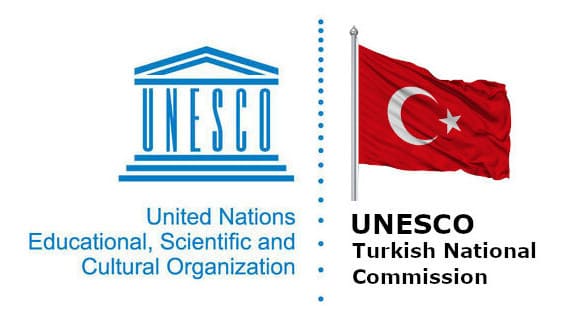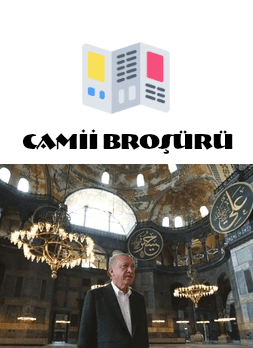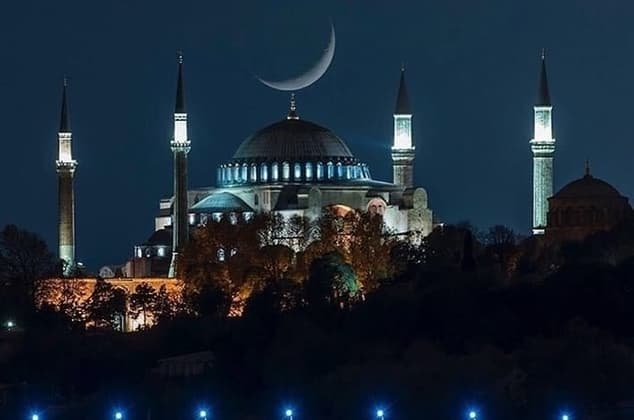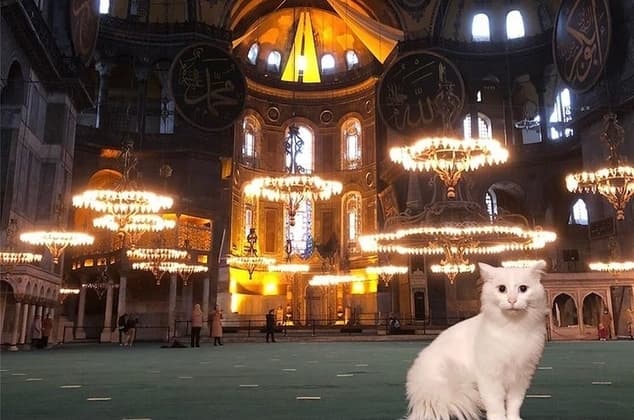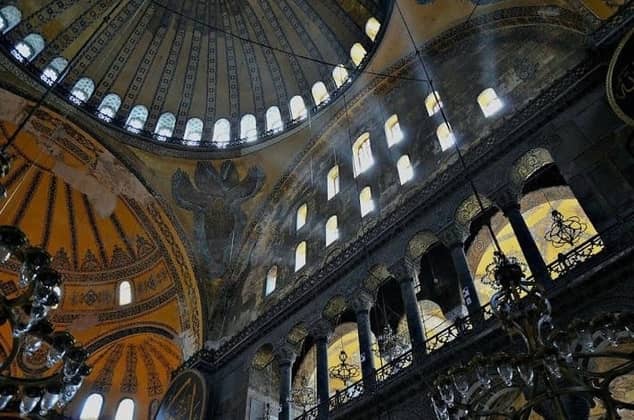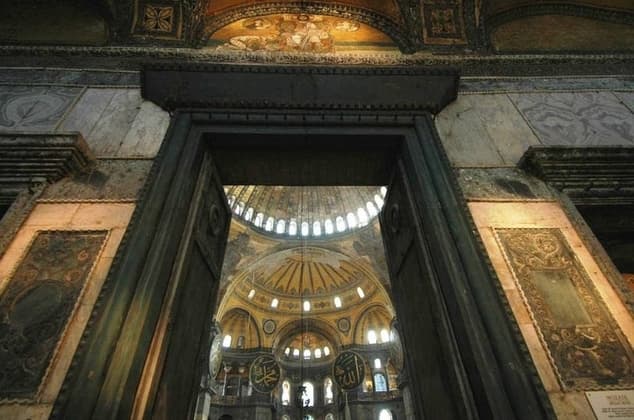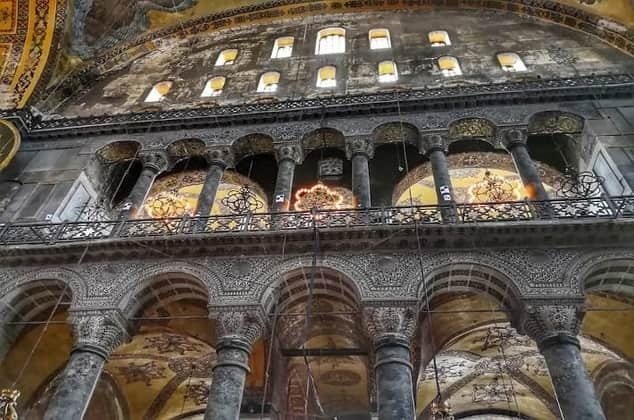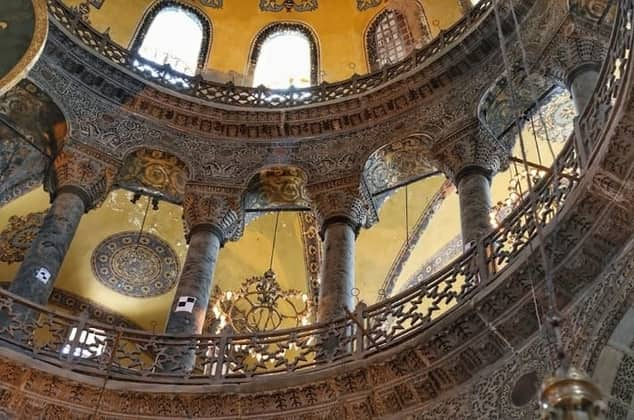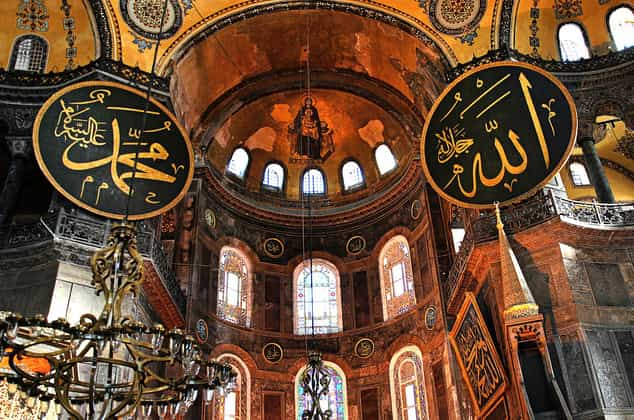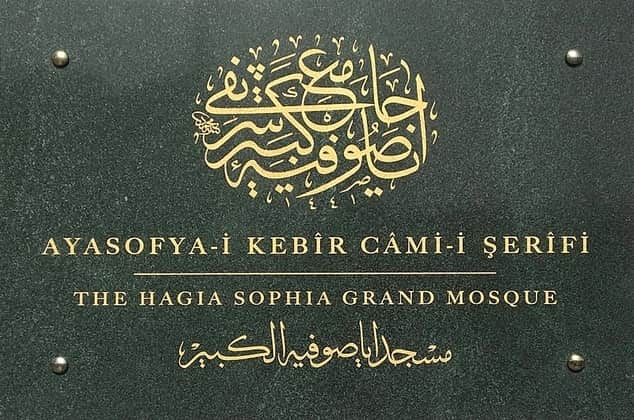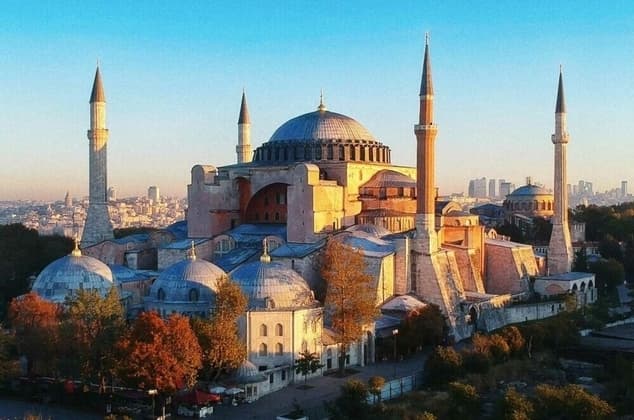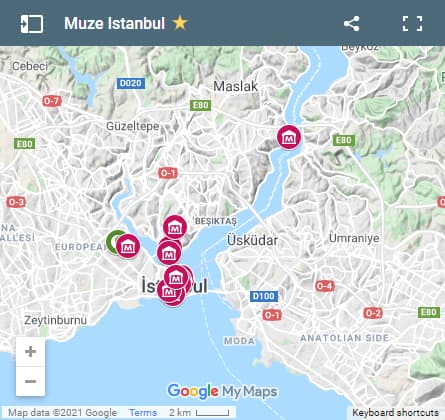ONCE A CHURCH, LATER A MOSQUE.
Masterpiece Of The History Of Architecture:
The Hagia Sophia Grand Mosque / Ayasofya-i Kebir Cami-i Şerifi, with its innovative architecture, rich history, religious significance and extraordinary characteristics has been fighting against time for centuries, was the largest Eastern Roman Church in İstanbul. Constructed three times in the same location, it is the world’s oldest and fastest-completed cathedral. With its breathtaking domes that look like hanging in the air, monolithic marble columns and unparalleled mosaics, is one of the wonders of world’s architecture history. The sheer dazzling beauty of mosque with its magnificent play on space, light, and color provokes worship in the believer! Hagia Sophia pose on the ground of the first hill of İstanbul, precisely at the tip of the historic peninsula, surrounded by the Sea of Marmara, the Bosphorus and the Golden Horn on three sides.
When it was first built, it was named Megale Ekklesia (Big Church); however, after the fifth century, it was referred to as the Hagia Sophia (Holy Wisdom). The church was the place in which rulers were crowned, and it was also the biggest operational cathedral in the city throughout the Byzantine period. The first church was constructed by Emperor Konstantios (337-361) in 360. The first church was covered with a wooden roof and expanded vertically (basilica) yet was burned down after the public riot that took place in 404 as a result of the disagreements between Emperor Arkadios’ (395-408) wife empress Eudoksia and İstanbul’s patriarch Ioannes Chrysostomos, who was exiled. The patriarch’s mosaic portrait can still be viewed at the tymphanon wall located in the northern part of the Hagia Sophia. No remains have been recovered from the first church; however, the bricks found in the mosque storage branded ‘Megale Ekklesia’ are predicted to belong to the first construction.
The second church was reconstructed by Emperor Theodosios II (408-450) in 415. This basilical structure is known to contain five naves and a monumental entrance; it is also covered by a wooden roof. The church was demolished in January 13, 532, after the public riot (Nika revolts) that took place during the fifth year of Emperor Justinianos’ reign (527-565), when the ‘blues’ who represented the aristocrats, and the ‘greens’ who represented the tradesman and merchants in the society, collaborated against the Empire. Remains found during the excavations led by A. M Scheinder of the İstanbul German Archeology Institute, 2 meters below ground level, include steps belonging to the Propylon (monumental door), column bases and pieces with lamb embossings that represent the 12 apostles. In addition, other architectural pieces that belong to the monumental entrance can be seen in the west garden.
Today's Hagia Sophia (Turkish:Ayasofya, Latin: Sancta Sophia, Spanish: Santa Sofia, Russian:Собор Святой Софии, literally:Holy Wisdom or Divine Wisdom) is the third building constructed in the same place with a different architectural understanding than its predecessors. Hagia Sophia considered the embodiment of Byzantine Architecture and also said changed the history of architecture. By the order of Emperor Justinianos, it was built by Anthemios (mathematician) from Tralles (today's Aydin) and Isidoros (geometrician and engineer) from Miletos (today's Balat). The construction started in 532 and was completed in a period of five years and opened for worship on December 27, 537 with great ceremony. Resources show that on the opening day of the Hagia Sophia, Emperor Justinianos entered the temple and said, “My Lord, thank you for giving me chance to create such a worshipping place,” and followed with the words “Süleyman, I beat you,” referring to Süleyman’s temple in Jerusalem. An earthquake swarm which hit the Constantinople from May 7,558 to following the years 546 and 557 were destructive. The dome of the Hagia Sophia collapsed and thousands of houses couldn't resist magnitude of quakes.
The Hagia Sophia and Byzantine city of Constantinople sacked and looted in April 1204 by the Venetians and the Crusaders on the Fourth Crusade which regarded as shocking betrayal amongst Christians. The crusader nobleman Baldwin of Flanders was crowned as emperor in Hagia Sophia, but most Byzantines refused to recognize him, and the empire fragmented into four small independent states.
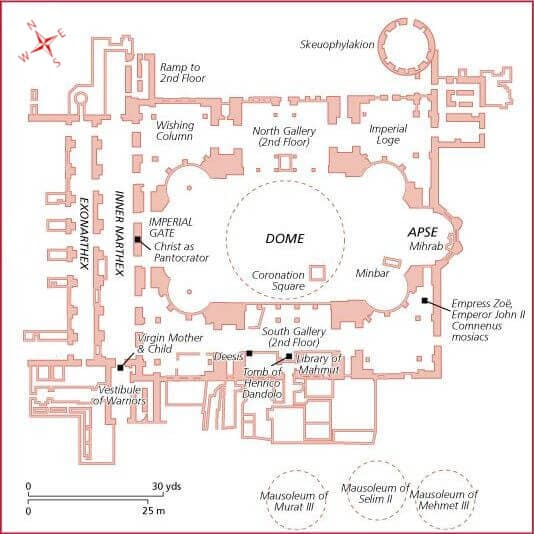
The third Hagia Sophia construction combined the three traditional basilical plans with the central dome plan in design. The structure has three nave, one apsi, and two narthex, internal and external. The length from the apsis to the outer narthex is 100 m, and the width is 69.5 m. The height of the dome from the ground level is 55.60 m and the radius is 31.87 m in the North to South direction and 30.86 in the East to West direction.
Emperor Justinianos ordered all provinces under his reign to send the best architectural pieces to be used in the construction so that the Hagia Sophia could be bigger and grander. The columns and marbles used in the structure have been taken from ancient cities in and around Anatolia and Syria, such as, Aspendus Ephessus, Baalbeek and Tarsa. The white marbles used in the structure came from the Marmara Island, the green porphyry from Eğriboz Island, the pink marbles from Afyon and the yellow from North Africa. The decorative interior wall coatings were established by dividing single marble blocks into two and combining them in order to create symmetrical shapes. In addition, the structure includes columns brought in from the Temple of Artemis in Ephessus to be used in the naves, as well as 8 columns brought from Egypt that support the domes.
The structure has a total of 104 columns, 40 in the lower and 64 in the upper gallery. All the walls of the Hagia Sophia except the ones covered by marble have been decorated with exceptionally beautiful mosaics. Gold, silver, glass, terra cotta and colorful stones have been used to make the mosaics. The plant-based and geometric mosaics are from the 6th century, whereas the figured mosaics date back to the Iconoclast period. During the East Roman period, the Hagia Sophia was the Empire Church and, as a result, was the place in which the emperors were crowned. The area that is on the right of the naos, where the flooring is covered with colorful stones creating an intertwining circular design (omphalion), is the section in which the Eastern Roman Emperors were crowned.
IT CONTINUED TO EXIST AS A MOSQUE DURING THE OTTOMAN PERIOD
When Sultan Mehmet the Conqueror conquered the Konstantiniyye (During the Ottoman period of ruling, following names used in Turkish for İstanbul:Konstantiniyye, Stanpolis, Dersaadet, Asitane), he converted it into his imperial mosque. Buttresses were added to the Hagia Sophia’s sides to prevent it from collapse during the reign of Murad III by the historical architect Sinan who would be inspired by the ancient edifice, and fusing its style with Islamic art and aesthetics in a series of Grand Mosques. The Hagia Sophia, whose domes and walls collapsed many times during the Eastern Roman period, never collapsed again after the renovations of Sinan the Architect despite many great earthquakes in İstanbul.
From the time of Fatih Sultan Mehmet Khan, every sultan strived to beautify the Hagia Sophia even more, and the Hagia Sophia was transformed into an entire complex with structures such as mihrab, minbar, rostrum, minarets, sultan’s office, shadirvans (fountain providing water for ritual ablutions), madrasah, library, and soup kitchen. In addition, great importance was attached to the interior decorations of the Hagia Sophia Mosque during the Ottoman period. Hagia Sophia was adorned with the most elegant examples of Turkish arts such as calligraphy and tile art and the temple gained new aesthetic values. Thus, İstanbul's Hagia Sophia was not only converted into a mosque but also this common heritage of humanity was preserved and improved. It continued its existence with the addition of Ottoman architectural elements, however after 4 years of closure to the public Hagia Sophia Mosque declared as a museum with the Council of Ministers Decision dated 24.11.1934 and served as a “Memorial Museum” held by General Directorate of Cultural Heritage and Museums Ministry. According to a deed dated 1936, the Hagia Sophia is registered as “Ayasofya-i Kebir Camii Şerifi on behalf of the Fatih Sultan Mehmed Foundation for maoseleum, akaret, muvakkithane and madrasah on 57 pafta, 57 island and 7th parcel. The Hagia Sophia has been a UNESCO World Heritage Site since 1985 as a section called the Historic Areas of İstanbul, which includes İstanbul’s other major historic buildings and monuments. Today it is a landmark of İstanbul and one of the most visited sights in Türkiye.
On July 10/2020, a Turkish top court reversed this 1934 Cabinet decree which turned Hagia Sophia Mosque into a museum, assist for its use again as a mosque after 86-year of gap. Judges decided that as the Hagia Sophia was owned by the Fatih Sultan Mehmet Khan Foundation / Waqf, the government did not have the right to change its status. Conquest of İstanbul gave the title of Roman Emperor to Fatih Sultan Mehmed Khan and possessed all the properties registered on the Byzantine dynasty and created the “Fatih Complex and the Hagia Sophia Al-Kabeer Foundation”. In Fatih Sultan Mehmed's waqfiyya (endowment document / foundation’s charter) which written on a 66-meter length of well preserved gazelle skin says: “All the things I have explained and designated here have been set down in written form in the foundation charter in the manner appointed; the conditions may not be altered; the laws may not be amended; they may not be diverted from their original purpose; the appointed rules and principles may not be diminished; interference of any sort in the foundation is interdicted… May the curse of Allah, the angels and all human beings be upon anyone who changes even one of the conditions governing this foundation.” Sultan Fatih refers to Hagia Sophia Grand Mosque as “kenise-i nefise-i münakkase“ in his wagfiyya which translated from Ottoman Turkish as “[the] exquisitely ornamented church.“
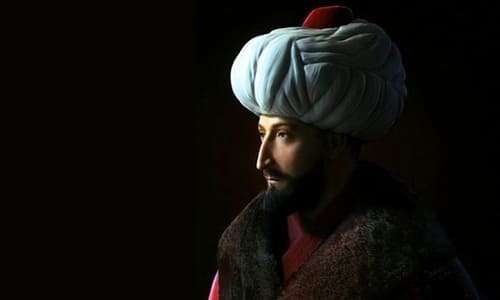
"To see the possibilities of the border got to try the impossible."
| Fatih Sultan Mehmet, the conqueror
The opening ceremony for worship in Hagia Sophia Mosque held on 24 July 2020, with the attendance of President of the Republic of Türkiye Mr. Recep Tayyip Erdoğan. Before the prayers, President Erdoğan recited from the Qur'an inside the reverted mosque, choosing verses from both the Surah Al-Fatihah and the Surah Al-Baqarah. Some 350,000 people participated in traditional Friday prayers at İstanbul's historic Hagia Sophia Mosque. Administrative duties for the mosque split between Türkiye’s Religious Affairs Directorate, or Diyanet, and the Ministry of Culture and Tourism. Diyanet administrate religious activities, while the latter continue to administer conservation and restoration projects, and the management of relics contained within the mosque. Addressing the nation regarding Hagia Sophia Mosque’s re-opening for worship, President Erdogan said: “Hagia Sophia’s doors will be, as is the case with all our mosques, wide open to all, whether they be foreign or local, Muslim or non-Muslim. With its new status, Hagia Sophia, the shared heritage of humanity, will continue to embrace all in a much more sincere and original way.”
Authorities announced that the features of Hagia Sophia will continue to be preserved and protected, and will remain open to the public in the same manner the Blue Mosque is open to visitors and tourists of all denominations and faiths. Apart from functioning as a working mosque, the Hagia Sophia is also among Türkiye's top tourism destinations for domestic and foreign visitors alike.
MOSAICS, SERMON CHAIRS: WELL WORTH SEEING!
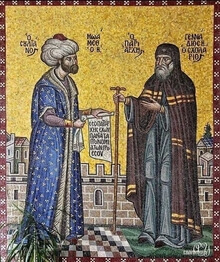
in 1453, Fatih Sultan Mehmed II
has guaranteed the religious
freedom of Christians.”
Hagia Sophia fascinates people by not only with its awe-inspiring architectural design, but also by its gold-plated, silver-plated, glass, terracotta and colored stone mosaics, and the original ceiling mosaics of the 6th century with their floral and geometric motifs. The mosaics with figures following the icon ban in the 8th century especially Mother Mary depicted with child Jesus in her arms, the Archangel Gabriel and the Archangel Michael and Deisis stage mosaics must be seen. Some of the most famous mosaics, including a Deisis panel and imperial portraits, are found in the southwest gallery, which was used for religious meetings and ceremonies.
Figures of four different angels are engraved on the pendants. These angels are depictions of Seraphim, believed to be guarding God's throne in heaven. The angels in the east were made of mosaics while the two angels in the west were deteriorated during the Eastern Roman Period and renovated as mural paintings. The faces of the angel figures were covered with star-shaped metal caps during the Ottoman period. An angel's face was exposed during the mosaic repairs on the dome in 2009.
Above the Imperial Door, at the feet of Jesus, there is a depiction of Leon VI (886-912), one of the Eastern Roman Emperors, paying homage to him. The mosaic depiction is dated to the 10th century. There is an offering mosaic dated to the 10th century on the Vestibule Gate to the south of the inner narthex. On this mosaic panel, Mary and Jesus as a child are depicted. On the left side of Mary, Emperor Constantine, the founder of the city, presents the castle model representing the city of Constantinople in his hand, and on the right side of Mary, Emperor Justinian presents the model of Hagia Sophia to her.
On the west wall of the south gallery, the Deesis Mosaic, which is mostly said to have been made in the 13th century, depicts Ioannes Prodromos (John the Baptist) on the right, Mary on the left, and Jesus in the middle. On the mosaic, the invocations of Mary and John to Isa for the forgiveness of humanity on the Day of Judgment are depicted. The large scale of the Chora Church (Kariye Camii) Deesis mosaics installed in inner narthex section alludes to the Hagia Sophia’s Deesis mosaics.
Empress Zoe and the Komnenos Mosaics
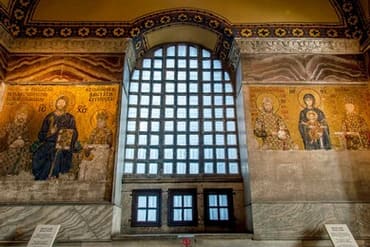
Mosaics.
Konstantinos Monomakhos Emperor IX. (1042-1055) and Empress Zoe are placed in the upper gallery mosaic board. The figure of Isa (Christ) is located at the center of Zoe mosaic. The writing on top of Emperor's head says "Romans' Religious Emperor, Servant of God's Jesus Konstantinos Monomakhos". The writing on top of Empress's head says "Devoutly Religious Agusta Zoe". On both sides of Pantocrator Jesus, king of the world, there are the initials of Jesus Christ IC and XC monograms. This mosaic board symbolizes the donations made by the emperor's family for the restorations of Hagia Sophia.Mosaic board dates back to 11th century.
The Komnenian Mosaic is located in the upper gallery, and the mosaic panel depicts Emperor John II Komnenos, his wife Irene (Eirene, former Piroska) of Hungary, and their son Alexios. In the middle of the composition, Mary is depicted standing with the child Jesus in her arms. The mosaic panel is dated to the 12th century.
Mosaic Tughra of Sultan Abdulmejid
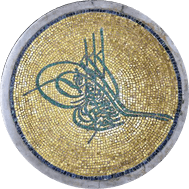
Sultan Abdulmecid's Mosaic tughra made by the Italian Master N. Lanzoni, who used the original golden gilded mosaic, pieces which had fallen out during the renovations made by the Fossati Brothers (Swiss-Italian architects) in Hagia Sophia between the years 1847-1849. The Tughra, which had been given as a gift to Sultan Abdulmecid by Fossati, had been engraved with green mosaics on a circular surface which consisted of golden gilded mosaic pieces. The outer borders of the mosaic tughra is ornamented by a single line of navy blue mosaic pieces. The mosaic tughra is important in terms of reflecting the Ottoman era for its design, as well as the Byzantine era for the used materials.
Madrasah, which built towards the north of Hagia Sophia during Fatih Sultan Mehmed’s reign was abolished in the 17th. Century and Fossati brothers rebuilt a madrasah in the same place during renovations as well. The remains were discovered during the excavations in 1982. Fossati brothers conservation and restoration of Haghia Sophia works lasted two years. More than eight hundreds men worked to reinforce the dome and surrounding semi-domes, cleaned the mosaics, replaced the chandeliers, and renovated the mihrab and the mimbar.
CALLIGRAPHIC ROUNDELS
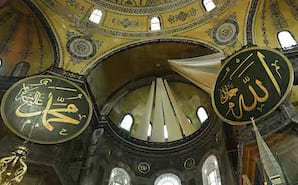
by Mustafa Izzet Efendi”
The calligraphic roundels hanging on the walls of the main hall were written by Kazasker Mustafa İzzet Efendi (1801-1876), one of the most famous calligraphers of the period, during the repairs made between the years of 1847 and 1849 in the reign of Sultan Abdulmejid (1839-1861). The 7.5 meter diameter calligraphic roundels bear the name "Allah" (swt), the Creator of the universe, "Muhammad" (saw), our beloved Prophet, his grandsons, "Hasan" and "Hussain", and four caliphs "Abu Bakr", "Uthman", "Umar" and "Ali". All these names are inscribed with gold gilding. Linden wood was used in the eight boards due to its lightness and durability. It is known to be one of the largest calligraphy roundels of the Islamic World.
The bronze lamps on two sides of the mihrab (altar) have been given as gifts to the mosque by Kanuni Sultan Süleyman (1520-1566) after his return from Budin.
MINARETS
Minarets are thin and tall structures built to recite the adhan and the salas in mosques. A wooden minaret was built on one of the semi- domes by Mehmed the Conqueror just after Hagia Sophia was converted into a mosque this minaret has not survived to the present day. When the brick minaret in the southeast of the mosque is examined in terms of style, it can be dated to the period of Mehmed the Conqueror or Bayezid II. It is thought that the minaret on the side of Bab-I Humayun (ceremonial gate of Topkapi Palace) may have been built by Sinan the Architect during the reign of Selim II, due to its similarity to the minarets of the Selimiye Mosque in Edirne. The identical minarets in the southwest and northwest directions were built by Sinan the Architect during the reign of Sultan Murad III. With their thick-bodied massive lines, the 60-meter-high minarets complete Hagia Sophia's main structure. The minarets were embellished with various decorations of the period during repairs in the 15th, 16th, and 19th centuries.
UPPER GALLERY
Grave Marker of Commander Enrico Dandolo
Opposite of the Deesis mosaic, on the ground, is the grave marker of Commander Enrico Dandolo, Doge of Venice, who led the 4th Crusade and died in İstanbul in 1205.
Viking Inscription at Hagia Sophia

|Click to Enlarge|
There is a Viking inscription on the marble parapets in the middle of the south gallery. The phrase "Halvdan was here" is written on this inscription, which has been dated to the 9th century. The inscription is thought to have been carved by a Viking soldier serving in the army as a mercenary during the Eastern Roman period. Probably, there may be additional runic inscriptions from the Viking age waiting to be discovered inside Hagia Sophia Mosque. So if you are visiting, you might find more specimens of ancient runes.
LUSTRATION URNS
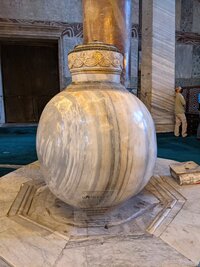
These urns, which are made of two solid marbles at the entrance and side naves of the building, belong to the Hellenistic Period (330-30 BC) and were brought to Hagia Sophia from the ancient city of Pergamon (Bergama) during the reign of Sultan Murad III (1574-1595). Sherbet (sweetened juice) was distributed on the holy nights and after 'Eid prayers by means of these urns, which could hold approximately 1250 liters of liquid. For this reason, there are taps at the bottom of the urns that contain water on other days.
OMPHALION
The Omphalion, the place where the emperors were crowned by the clergy during the Byzantine Empire, is a special section with marble circles of different colors and sizes around one large marble circle.
DOME (QUBBAH)
The mosque's main dome stands 55.6 meters tall and has a diameter of approximately 32 meters. The dome was originally built flat, but over time it was raised and took on its current shape. The final form of Hagia Sophia's dome was given by Mimar Sinan (Sinan the Architect).
In Turkish-Islamic architecture, the dome represents the heavens and the oneness of Allah. For this reason, verses about monotheism, sky, the sun, stars and light in the Qur'an are written on the domes. On the dome of the Hagia Sophia Mosque, the following verse in the Qur'an is seen: "Allah is the Light of the heavens and the earth. His light is like a niche in which there is a lamp, the lamp is in a crystal, the crystal is like a shining star, lit from (the oil of) a blessed olive tree, (located) neither to the east nor the west, whose oil would almost glow, even without being touched by fire." (Nur, 24/35) It is written by Kazasker Mustafa Izzet Efendi, one of the most important calligraphers during the reign of Sultan Abdulmejid.
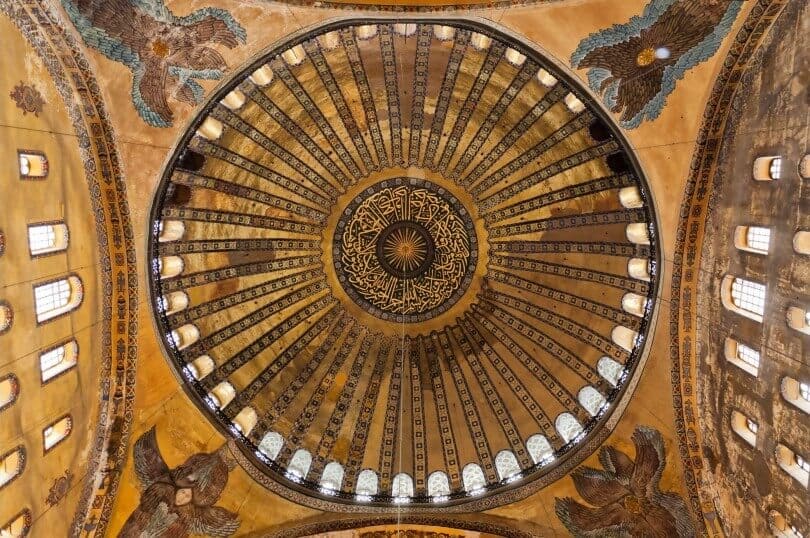
DOORS OF HAGIA SOPHIA
Imperial Door
Providing the passage from the inner narthex to the main hall, it is the largest door of Hagia Sophia from the 6th century. The 7-meter-tall Imperial Door has a bronze frame and is made of oak wood. The door, whose wings were covered with bronze plates, was used only by the Emperor and his entourage.
Beautiful Door
Located at the entrance of the inner narthex, dated to the 2nd century BC and brought to Hagia Sophia, the bronze door is the oldest architectural element of the mosque. Removed from an ancient pagan temple in Tarsus in 838 and brought to Hagia Sophia by Emperor Theophilos (829-842), the door is decorated with monograms as well as various vegetal and geometric patterns in relief.
Marble Door
The south gallery, where the patriarchate officials would hold their religious meetings, is separated from the west gallery by a marble door. It is said that one side of the marble door represents heaven and the other side represents hell. Since Hagia Sophia was the Imperial Church, it is known that it was used as a place where the state's decisions regarding religious affairs were also taken. In 1166, during the reign of Emperor Manuel Komnenos, the Synod Assembly was also convened here. The decisions taken in the assembly were inscribed on marble plates and hung on the wall of the outer narthex. Today, the panels in the outer narthex are replicas of the originals.
HAGIA SOPHIA BATHHOUSE (Hammam)
Hagia Sophia Bathhouse is a two-sectioned bathhouse built by Mimar Sinan in 1553 just opposite the Hagia Sophia Mosque under the name of "Merhume Haseki Sultan Hamamı" in order to provide income for the foundations of Hürrem Sultan, the wife of Suleiman the Magnificent. Hagia Sophia Bathhouse, one of the biggest and most beautiful bathhouses in İstanbul, is still actively used today as Hürrem Sultan Hamamı.
FOREIGN TOURIST VISITING RULES AND VISITOR MANAGEMENT SYSTEM
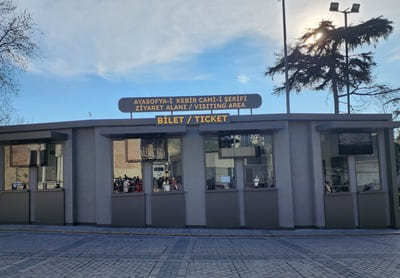
Bab-ı Hümayun Cad. (Street)
As of Monday January 15th, 2024 visitors from foreign countries will be allowed to enter Hagia Sophia from a newly established temporary gate located across Sultan Ahmed III Fountain (GoogleMaps). Ticket booth is also located across from the Sultan Ahmed III Fountain, Both entrance gate and ticket booth can be found easily by getting to the Topkapı Palace Museum's Imperial Gate (OpenStreetMap) a.k.a. “Bâb-ı Hümâyun” gate.
Visitors will be transported to the gallery floor by a ramp after entrance gate and will be able to see the sanctuary floor of the mosque and the Ottoman period annexes, pass through the Heaven and Hell gate (Marble Door), and examine the Byzantine period mosaics. The upper gallery exit will be via the ramp in the northeast direction (See the floor plan above - "Ramp to 2nd Floor"). Hagia Sophia visitors will be able to receive information in 23 languages (AR technology) through their mobile phone headsets with a QR code application without disturbing the worshipers. Protective measures were taken along the tour route, such as security cameras, fire detection and emergency announcement systems.
Due to ongoing restoration and protection work at Bayezid II minaret on the northeast side of the mosque, a temporary entrance gate installed for visitors protection. When ongoing work is completed, scaffoldings and this temporary gate will be removed and the gate under Bayezid II minaret will be used as the main entrance of the visiting area.
Entrance Fees, Visiting Etiquette
Entrance is free of charge for children under the age of 8, accompanied by an adult and presenting a valid passport or ID card. ICOMOS and IPC, press cards are not valid for entrance to the visiting area of Hagia Sophia. Ticket price is 25€ (Euro), Euro to Turkish Lira exchange rate is applied according to management policies and can be seen at ticket booth / visiting area. Visiting area AR (Augmented Reality) experience requires for visitors to use headphones with your phone or tablets. Headphones are also available at the ticket booth for visitors to Hagia Sophia Mosque.


"Visiting Area" entrance - exit ramps and stairs are not suitable for disabled people and individuals with walking difficulties. These visitors are kindly requested to use the "Turkish Citizen Entrance" with their tickets.
General mosque visiting etiquette is required for all visitors. Women should wear a head covering when entering to the Hagia Sophia Mosque. Headscarves and body covers are available at the ticket booth with a small fee (headscarf:€1, body cover:€3). Please be respectful of the mosque's sanctity. Since Hagia Sophia is a place of worship please respect the Muslim rules of worship, avoid staring or taking pictures of Muslims praying (performing namaz) during your visit. Walking is recommended inside the mosque. For the preservation of our historic floors, please fold and carry your stroller while inside the visiting area of Hagia Sophia. By entering, you agree to comply with the rules to ensure a peaceful visit for everyone.
Foreign nationality Muslims should enter the mosque's praying area from main gate which is at Hagia Sophia Square (Ayasofya Meydanı) before prayer times for pray salah. Please kindly note that praying area of the mosque is closed to visit for daily cleaning and maintenance purposes from morning prayer untill 10:00 AM. Check prayer times for İstanbul here.
Opening hours, Tickets
Hagia Sophia is open to visitors every day, opening hours from 09:00 a.m. to 7:30 p.m. in 2025. Visiting area of the mosque is closed to visitors between 12:30-14:30 due to Friday Prayers. Admission tickets can be purchased from the ticket booth and online (Skip-the-Line) through official seller DEM MUSEUMS with below link. There are no Museum Passes available for visiting the Hagia Sophia.
Augmented reality interactive experience, available languages;
WHILE YOU ARE HERE
The Hagia Sophia Mosque is famous for its exterior as well as its interior. The mausoleums of Ottoman Sultans outside the building are among the first to visit. There are tombs of princes and mausoleums of Sultan Selim II, Sultan Murad III, Sultan Mehmed III, Sultan Mustafa I, and Sultan Ibrahim whose reigns followed one another. Hagia Sophia Grand Mosque more than just a monument to the grandeur of human achievement and artistic expression. It also serves as the final resting place for five sultans and their families, giving it a venerated historical status befitting its age and history. The four minarets of Hagia Sophia, known to be built by Mimar Sinan, the fountain of Sibyan (elementary) school, the clock room, the fountains, buttresses, the treasury building and the soup kitchen are also increasing the magnificence of the structure.
GUIDED TOURS
Hagia Sophia marvel has so many stories to portray from the Byzantine era to the Ottoman Empire, this legendary building is the greatest symbol of İstanbul. A Hagia Sophia tour is a must when you explore historic peninsula, which has a special place in history as a architectural gem.
See Also
- http://istanbul.gov.tr/ | Ayasofya-i Kebir Cami-i Şerifi Cuma Namazıyla İbadete Açıldı
- https://islamansiklopedisi.org.tr/ | Ayasofya
- https://ayasofya.fsm.edu.tr/ | FSM Ayasofya
- https://www.kulturportali.gov.tr/ | Ayasofyai Kebir Camii - İstanbul
- https://www.khanacademy.org/ | Hagia Sophia as a Mosque / medieval-europe-islamic-world
- https://www.vgm.gov.tr/ | The Hagia Sophia Grand Mosque.
- http://envanter.gov.tr/ | Monument Inventory.
- https://scholar.harvard.edu/ | Hagia Sophia from the age of Justinian to the present
- https://ayasofyacamii.gov.tr/ | Virtual Mosque Tour

